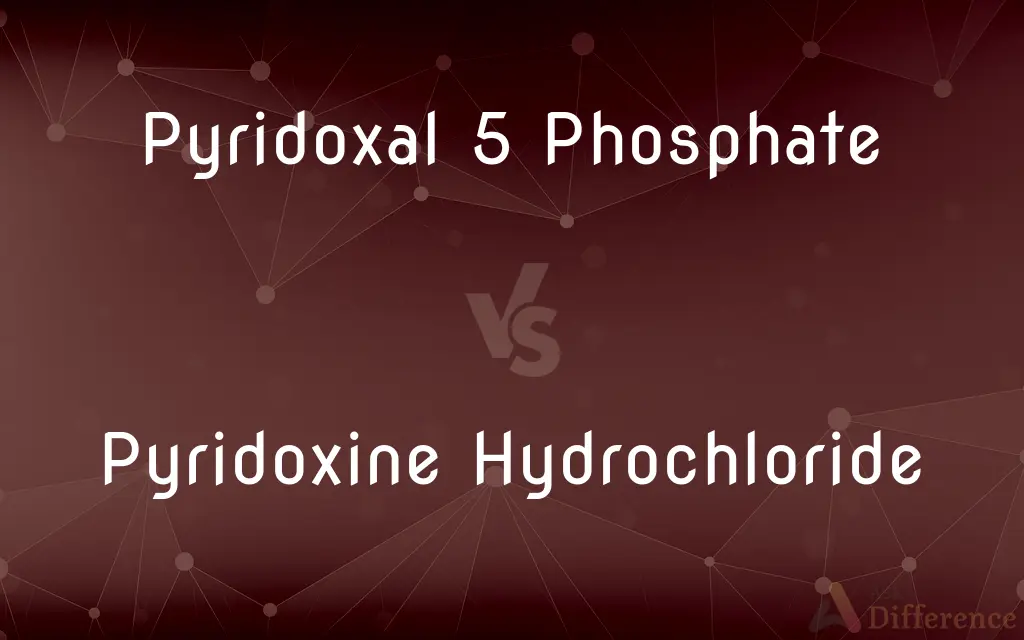Pyridoxal 5 Phosphate vs. Pyridoxine Hydrochloride — What's the Difference?
By Tayyaba Rehman & Fiza Rafique — Published on February 21, 2024
Pyridoxal 5'-phosphate (PLP) is the active form of Vitamin B6 involved in enzyme function, whereas Pyridoxine Hydrochloride (Pyridoxine HCl) is a stable, salt form of Vitamin B6 used in supplements and fortified foods.

Difference Between Pyridoxal 5 Phosphate and Pyridoxine Hydrochloride
Table of Contents
ADVERTISEMENT
Key Differences
Pyridoxal 5'-phosphate (PLP) and Pyridoxine Hydrochloride (Pyridoxine HCl) are two different forms of Vitamin B6, each with distinct roles and characteristics. PLP serves as a coenzyme in various enzymatic reactions, particularly those involved in amino acid metabolism, neurotransmitter synthesis, and hemoglobin synthesis and function. It is the biologically active form of Vitamin B6 within the body, essential for the proper functioning of over 100 enzyme reactions.
Pyridoxine Hydrochloride, on the other hand, is a commonly used form of Vitamin B6 in dietary supplements and food fortification due to its stability and solubility in water. Upon ingestion, Pyridoxine HCl is converted in the body to the active form, PLP, through a series of phosphorylation steps. This conversion is necessary for Pyridoxine HCl to participate in the biochemical functions typically associated with Vitamin B6.
PLP is directly involved in enzyme catalysis and metabolic processes, on the other hand, Pyridoxine HCl is primarily an ingestible form of Vitamin B6 that requires metabolic activation. The significance of PLP in human health is highlighted by its role in the metabolism of proteins, lipids, and carbohydrates, as well as in the synthesis of important neurotransmitters like serotonin, dopamine, and gamma-aminobutyric acid (GABA).
The administration of Pyridoxine HCl as a supplement or medication aims to increase PLP levels in the body, especially in conditions of Vitamin B6 deficiency, which can lead to symptoms such as anemia, dermatitis, depression, confusion, and a weakened immune system. Both forms of Vitamin B6 are crucial for maintaining overall health, but they serve different purposes in dietary and medical applications.
The choice between Pyridoxal 5'-phosphate and Pyridoxine Hydrochloride depends on the context of use—PLP as the active coenzyme within the body and Pyridoxine HCl as a stable form for supplementation and fortification.
ADVERTISEMENT
Comparison Chart
Form
Active coenzyme form of Vitamin B6
Stable salt form of Vitamin B6
Role in Metabolism
Directly involved in enzyme catalysis
Converted to active form (PLP) in the body
Use
Intrinsically involved in biochemical processes
Used in supplements and fortified foods
Importance
Essential for amino acid metabolism, neurotransmitter synthesis
Prevents Vitamin B6 deficiency, supports overall health
Stability
Less stable, not typically used in supplements
Stable, water-soluble, suitable for oral supplementation
Compare with Definitions
Pyridoxal 5 Phosphate
Involved in over 100 enzyme reactions.
PLP is crucial for the metabolism of essential amino acids.
Pyridoxine Hydrochloride
Used to treat or prevent Vitamin B6 deficiency.
Pyridoxine HCl supplements can alleviate symptoms like dermatitis and anemia.
Pyridoxal 5 Phosphate
The active enzymatic form of Vitamin B6.
PLP acts as a coenzyme in the synthesis of neurotransmitters.
Pyridoxine Hydrochloride
Requires conversion to PLP in the body.
After ingestion, Pyridoxine HCl is phosphorylated to become biologically active.
Pyridoxal 5 Phosphate
Directly participates in metabolic processes.
PLP plays a role in converting tryptophan to niacin in the body.
Pyridoxine Hydrochloride
Water-soluble and easily absorbed.
Pyridoxine HCl is the preferred form for oral Vitamin B6 supplementation.
Pyridoxal 5 Phosphate
Essential for neurotransmitter and hemoglobin synthesis.
PLP deficiency can lead to neurological symptoms and anemia.
Pyridoxine Hydrochloride
Common in fortified foods.
Breakfast cereals often contain added Pyridoxine HCl for nutritional enhancement.
Pyridoxal 5 Phosphate
Not commonly used in dietary supplements.
Due to its instability, PLP is not the preferred form for Vitamin B6 fortification.
Pyridoxine Hydrochloride
A stable form of Vitamin B6 used in supplements.
Pyridoxine HCl is added to multivitamins to prevent B6 deficiency.
Common Curiosities
Why is Pyridoxine HCl preferred in supplements over PLP?
Pyridoxine HCl is more stable and soluble, making it suitable for oral supplementation and food fortification.
What is Pyridoxal 5'-phosphate?
Pyridoxal 5'-phosphate (PLP) is the active form of Vitamin B6, serving as a coenzyme in numerous enzymatic reactions.
Can you get PLP from dietary supplements?
Most supplements contain Vitamin B6 as Pyridoxine Hydrochloride, which the body converts to PLP; direct PLP supplements are less common.
What are the symptoms of Vitamin B6 deficiency?
Symptoms can include anemia, dermatitis, depression, confusion, and a weakened immune system.
What is Pyridoxine Hydrochloride used for?
Pyridoxine Hydrochloride is used as a dietary supplement and in food fortification to prevent or treat Vitamin B6 deficiency.
How does the body use Pyridoxine Hydrochloride?
The body converts Pyridoxine Hydrochloride into the active form, PLP, which is then used in various metabolic processes.
Can taking Pyridoxine HCl supplements lead to toxicity?
High doses of Pyridoxine HCl can lead to neurological disorders, so supplements should be taken within recommended limits.
Are there any foods rich in PLP?
Foods contain Vitamin B6 in various forms, which the body converts to PLP; rich sources include poultry, fish, potatoes, and bananas.
How is PLP involved in amino acid metabolism?
PLP acts as a coenzyme for enzymes that catalyze reactions in the metabolism of amino acids, such as transamination and decarboxylation.
Is PLP better than Pyridoxine HCl?
PLP is the active form required for enzyme function, but Pyridoxine HCl is more practical for supplementation due to its stability.
How does Vitamin B6 support the nervous system?
Vitamin B6, in its active form PLP, is essential for the synthesis of neurotransmitters like serotonin and dopamine, supporting brain health.
What role does PLP play in hemoglobin function?
PLP is involved in the synthesis of heme, an essential component of hemoglobin, and in modulating hemoglobin's ability to bind oxygen.
What factors can affect Vitamin B6 requirements?
Factors include age, gender, physiological states like pregnancy, medication use, and conditions like renal disease or malabsorption.
Can Vitamin B6 supplements interact with medications?
Yes, Vitamin B6 can interact with certain medications, such as isoniazid and cycloserine, affecting their efficacy or leading to deficiency.
Share Your Discovery

Previous Comparison
SDS Page vs. Native Page
Next Comparison
PUBG Lite vs. Free FireAuthor Spotlight
Written by
Tayyaba RehmanTayyaba Rehman is a distinguished writer, currently serving as a primary contributor to askdifference.com. As a researcher in semantics and etymology, Tayyaba's passion for the complexity of languages and their distinctions has found a perfect home on the platform. Tayyaba delves into the intricacies of language, distinguishing between commonly confused words and phrases, thereby providing clarity for readers worldwide.
Co-written by
Fiza RafiqueFiza Rafique is a skilled content writer at AskDifference.com, where she meticulously refines and enhances written pieces. Drawing from her vast editorial expertise, Fiza ensures clarity, accuracy, and precision in every article. Passionate about language, she continually seeks to elevate the quality of content for readers worldwide.
















































